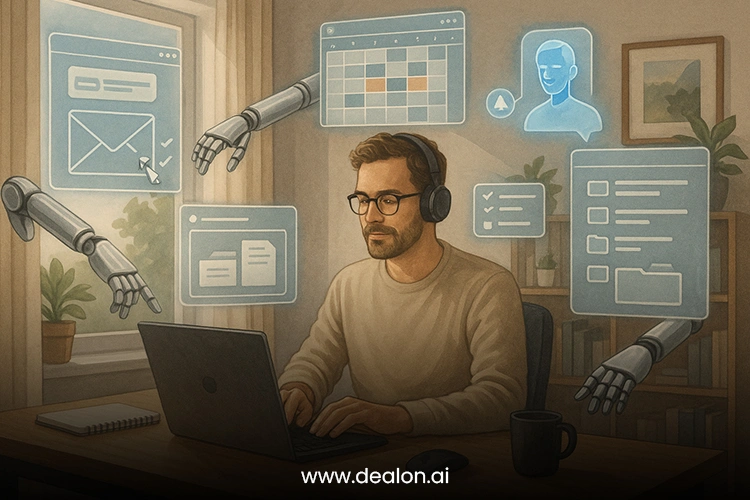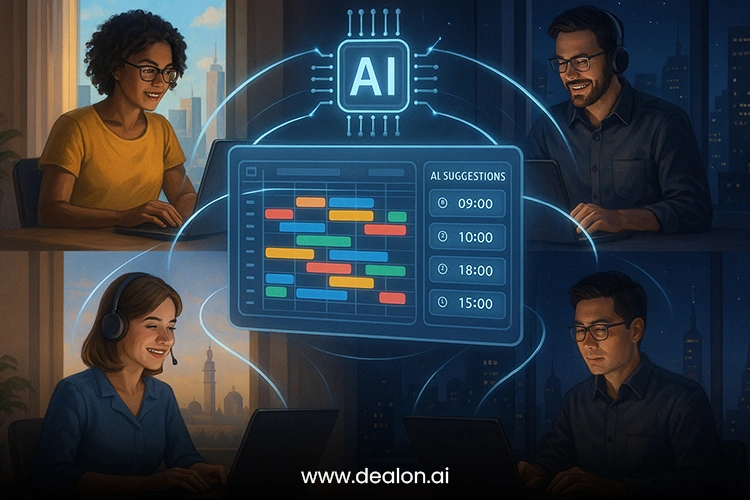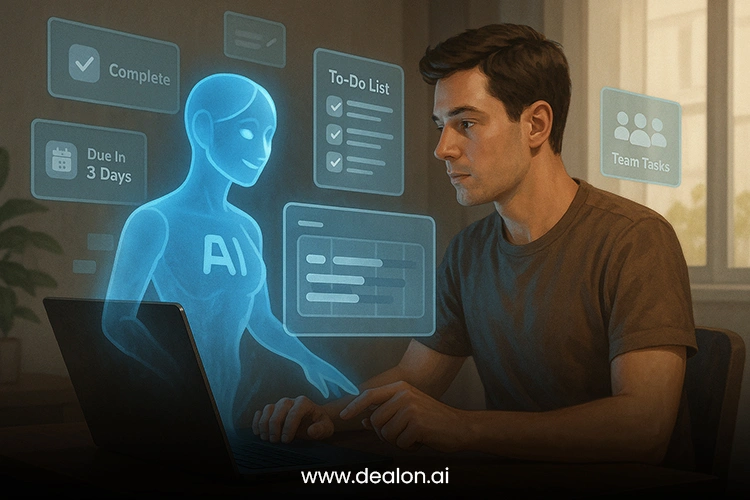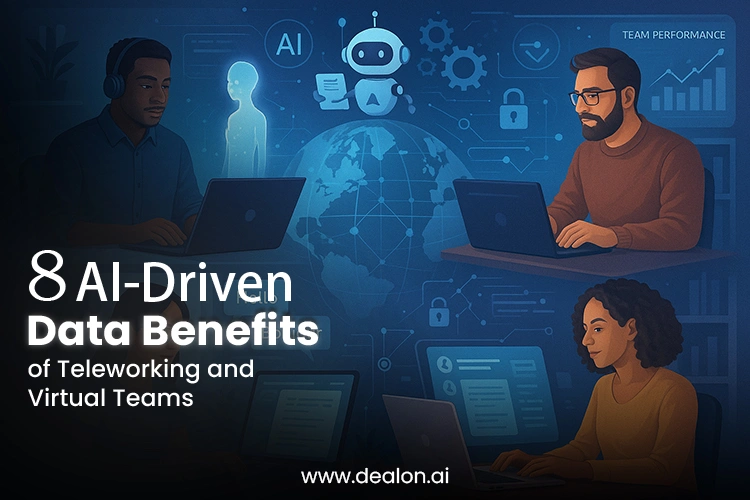The world is rapidly changing to telework, and the necessity of collaborating in a smooth working environment and producing more has never been so urgent. In the age of working virtually, the use of artificial intelligence is becoming a revolution, and workplaces are becoming more efficient with remote teams communicating, working, and winning over distance. Not anymore relating to the rigid office environments, AI is becoming that cognitive bridge between the distant workers and directing some very new solutions at the incredibly convenient working process streamlining, company collaboration, and performance, in general.
How AI can affect remote work is extensive, including automating monotonous duties and providing real-time data that enables superior decision-making. The implementation of AI-powered tools into daily working processes improves efficiency as well as opens the possibility of more intelligent collaboration, offering data-infused solutions. This AI-enabled intelligence may be in the form of virtual assistants that use AI to manage day-to-day operations, or intelligent scheduling systems that optimize team meetings and organize tasks to fit the unique requirements of remote working environments.
More than that, AI is not only about productivity, but it also boosts security, the analysis of data, and communications, making sure that remote teams can collaborate and function effectively even when geographically separated. Real-time language interpretation and even more co-creation platforms enable effective communication within a diverse and multilingual team. In contrast, artificial intelligence-enhanced performance monitoring tools provide an opportunity to keep the workforce engaged and on task.
This blog will discuss the eight creative ways that AI can leverage on top of remote work and virtual collaboration processes, including enhancing routine procedures and strengthening the team. With the further development of remote jobs, the importance of AI as a driver of security will be pivotal in the successful work of organizations in a world that is quickly going digital.
Also Read: 6 Ways Explainable AI is Strengthening Trust in Machine Learning Decisions
1. AI increases productivity by automating routine tasks

Automation of the routine tasks that AI is capable of is something that will radically transform remote working, unlocking incredible potential in terms of data-driven productivity and efficiency. The virtual collaboration world is dynamic, and ordinary, routine tasks, such as arranging meetings, checking emails, and organizing documents, can all easily eat into valuable time that would otherwise be spent on more high-level, high-impact activities. That is where the AI-based tools come in as virtual assistance tools that can accomplish these tasks on their own by analyzing data from schedules, communications, and project timelines.
As an example, virtual assistants belonging to the AI industry can plan meetings by reading the data from the schedules of the participants, identifying the free time, and inviting the guests without the imposition of any human element. The priority and organization of email inboxes can also be done via these systems in an automated fashion, where messages are sorted based on data patterns, marked as urgent, and even responses can be typed out in some cases to respond to routine questions. Also, AI programs are able to manage the data involved in digital correspondence organization, document clarification, folder division, and simple accessibility of the necessary documents, while decreasing the time on administrative duties to a minimum.
AI automates these repetitive tasks using data analysis so that a remote workforce can spend their time on roles that need creative searching, command, or problem-solving abilities, which add more value to the business. Automation of repetitive labor not only speeds up the process of work but also reduces the possibility of human error. As an illustration, AI tools will ensure that there are no overlapping meetings, unsent emails, and that data-driven deadlines are always met.
2. Wise Duration to Flawless Cooperation

The most challenging part of remote work regarding the coordination of time zones is organizing schedules. Once the teams are spread all over the world, they might find it challenging to come across a time when they are all available, and at the same time, they might find it difficult to communicate via email, and you might find that people are in diverse time zones. It is here that the AI-boosted scheduling trafficking out technology provides an enabling solution, by automating all scheduling procedures and offering the most efficient meeting scheduling operations.
The team management tools provided by AI could quickly examine the calendars, time zones, and availability of the team members and open the possibility to avoid back-and-forth coordination. The systems come with automatic time proposals that are based on the local time and the favorable working time of each person, resulting in the best time that can be suited by all. These attributes allow AI to minimize human error and the level of complexity created when calculating time zones. As a result, people in different locations end up on the same page regarding scheduled meetings.
In addition to simple time-available slot-selection, intelligent scheduling apps can take individual preferences (maybe not early mornings, or late evenings) into account and automatically correct recurrent meetings so that regular check-ins or groups of collaborators can be convenient. The AI could also sort requests by the level of urgency, thus making sure that emergent discussions were carried out at the most convenient time.
3. Real-Time Communication with AI-powered Real-time Language Translation
In virtual teamwork, communication is crucial, particularly in situations when employees do not live in the same country and may have various mother tongues. Language is one of the delays in terms of interaction, as in such a wide setting, language differences are bound to induce difficulties in achieving progress and clear understanding. That is where real-time language translation AI of communication tools (called revolutionized global collaboration) comes to the rescue.
Instantaneous and accurate translation of both written and verbal exchanges can be performed with AI-driven translation software that has been built into video conferencing platforms, messaging software, and collaboration software. These applications employ natural language processing (NLP) algorithms to comprehend and interpret live conversations and dissolve language barriers hassle-free.
As an example, when held through a video conference, AI may automatically translate spoken words into subtitles, thus allowing parties in a video conference with varied linguistic backgrounds to participate in the discussion actively and without delays or misunderstanding.
In the context of text-based communications, AI-based software can be used to translate instant messages, emails, and documents as well as facilitate synchronous work in the context of being a multilingual interaction. Thanks to real-time translation, the members of the team can communicate with each other in their native language, which feels natural, but at the same time remain completely aware of everything that was said and involved in that conversation.
4. Digital assistants to optimize tasks and workflow

The most recent innovation by AI-powered virtual assistants has played a key role in aiding remote workers to increase productivity and assist in the smooth running of activities between individuals or teams. These assistants utilize the force of machine learning as well as NLP, which helps to automate mundane operations, letting the user devote their attention to other areas that are more strategic and creative. Through prioritizing, making reminders, and keeping up with deadlines of every project, virtual assistants will keep remote employees organized and deadline-compliant.
Prioritization of the element of urgency and importance is among the main benefits of virtual assistants that are AI-powered. These assistants are able to read your calendar, types of emails, and even in-progress projects to advise you on what tasks are to come next, and so that remote workers can have control over their tasks at hand without omitting essential deadlines. Also, they are able to issue automatic reminders so that users do not forget to do their assignments and attend their meetings, so as to be able to maintain the same pace of productivity throughout the day.
Virtual assistants can support collaborative work on top of individual task management by providing an organised to-do list to share with others, monitoring the progress of team efforts, and informing all concerned in real-time. These AI tools will create smooth collaboration by centralising work with everybody on the same page, especially when they are working in teams that are dispersed in various time zones. Each person within the remote team can monitor the progress of others and report back and update their work with others all the time, cutting through clear communication without calling their colleagues every now and then.
5. Performance Reporting and Feedback that is based on AI
This is because in a remote workplace scenario, it is sometimes difficult to oversee the performance of employees and be able to offer real-time and actionable feedback. The managers do not enjoy the oversight that they would get in the traditional office since team members are scattered in different places. This is the place where performance monitoring tools that rely on AI are changing how businesses monitor and maximize the productivity of workers.
The AI-driven systems are created to monitor key performance, productivity measures, and the quality of work in real-time. These tools provide a panoramic assessment of individual and group performance by comparing the data received in various areas (bright communication patterns, task completion speed, and project schedule). As an example, AI can evaluate the quality of the work according to predetermined standards and monitor the effectiveness of completing tasks, as well as evaluate employee activity through trends in working connections or activity rates.
The AI-driven instruments do more than tracking since they provide data-based feedback, which enables managers to know where to improve and what to do even strongly. The form of input for AI is objective and oriented to measurable outcomes of performance, which eliminates any ambiguity that can occur due to subjective criticism. Employees are given positive reflections on how they can change their work patterns, work more efficiently, and on the whole, improve the nature of their work and create a culture of continuous improvement.
6. Improved Home Office on a Collaborative Basis
An essential issue in remote working is security; the secrecy of business data can be compromised through networks that do not offer a high level of security. As more and more companies have to depend on digital platforms, the need to ensure that their data is secure and virtual teamwork is not compromised is growing. AI is also significant in helping to damp down these risks, given that it offers sophisticated security measures that protect such data and boost the integrity of such remote-based working systems.
The security tools with AI incorporated can be powered by machine learning algorithms that help in studying traffic on the network and identifying the existence of suspicious activity at any time. This feature provides a level of security unavailable to conventionally developed systems, as these tools are capable of identifying an atypical pattern, the initiation of unauthorized access, or possible system security violations in real-time. The AI can help organizations to take precautions a step ahead of any cyber attacks by detecting the vulnerabilities before they can be used against an organization.
Moreover, the AI systems could help to detect fraud through the examination of patterns within the behaviour of the employees. These systems can raise red flags during any abnormal access to sensitive data, delayed logins, or sudden alterations in communication patterns. These lies, unusual activity, and anomalous behavior may easily be detected by AI, and security teams could get warnings and initiate an investigation and reaction in time.
7. Real-Time Document Sharing and Collaboration Platforms on Artificial Intelligence
The collaboration tools, such as Google Workspace, Microsoft Teams, and Slack, have already revolutionized how teams can carry out their work remotely. But the incorporation of AI-enabled tools is putting these platforms to new heights of efficiency and functionality. AI is improving the collaboration experience with real-time editing, content recommendations, and integrated version control so that teams can work more efficiently and in harmony.
Use of AI-based tools for document collaboration helps the team members to review and share the documents in real-time, thereby bringing everyone on the same page at the given stage of the process. In addition to simple editing, AI can provide innovative improvements where grammar and tone suggestions can be given, as well as stylistic advice to make it sound more transparent and coherent. This makes the end product not only well written but professionally created with the same voice, given that the entire team contributes to it.
Moreover, the version control is enhanced on AI-powered collaboration platforms, with the changes being automatically tracked and saved, team members can revert to a previous draft or compare two versions of the document with one another. This will remove the possibility of losing the work and accidentally or unknowingly working on old files. Reviewing is also simplified because AI can point out significant changes or additions so that members of the team can see the critical areas of the text.
8. AI-Augmented Data Analysis to Inform the Decision-Making
Data analytics has been unable to define team performance, the progress of projects, and to see productivity trends in the sphere of remote work. But a vast amount and complexity of data may defeat any attempts to analyze it with a manual analysis method. It is here that AI-empowered data analytics comes in, providing impressive tools that trawl through large volumes of data and provide business-relevant, lab-ready information that teams working remotely can use to make informed decisions grounded in information.
Such systems learn the most critical performance indicators (KPIs) that could be missed through machine learning algorithms and provide the business with a clearer insight into their operations. As an example, AI can monitor the performance of home-based employees, examining the rate of task completion, frequency of communication, as well as sentiment during those communications, and give managers more details about the interactions and performance of a group of employees.
In addition, the AI analytics tools allow teams to change direction in response to changing conditions. Armed with real-time insights, remotely located teams will be able to optimize the work processes, modify the project schedule, and redistribute the resources. This does away with facile manual data procedures and allows a business firm to take action based on the most pertinent information as soon as it is available.
Conclusion
The introduction of AI is completely transforming remote work because it leads to increased productivity, improved collaboration processes, and valuable insights that can assist the team in making better decisions. Eliminating redundant tasks, ensuring efficient scheduling, and removing the barricade that is the language barrier through real-time translation, AI-powered tools are making remote work easily accessible and efficient. The use of virtual assistants will improve the handling of tasks, and the AI-driven performance tracking will allow constant feedback to guarantee the team performs in unison, even with geographical barriers keeping them apart.
Besides, AI is considered instrumental in remote working landscapes, such as suspicious activity detection and supporting data protection procedures. It is also more collaborative due to the real-time document sharing and editing, and thus, seamless communication as well as making everyone on the same page. When AI is applied to data analytics, businesses can monitor their performance, streamline operations, and make safe data-driven decisions.

